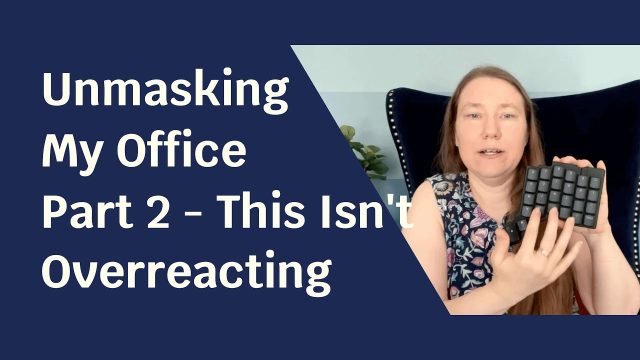
Keyboard and monitor problems
In part one, I talked about how wanting an ergonomic mouse turned into this whole big project in my mind. I talked about how it wasn’t overthinking, but was problem-solving and what the differences are.
In the end, I only ended up buying the mouse, and made my own mouse pad out of an old book, and was reasonably satisfied with that, but a few weeks later, it turned into a much bigger project, taking a direction I wasn’t expecting, and that’s what I want to talk about today.
Because many people would consider what I did next as overreacting, or dramatizing, or blowing it out of proportion, or making a big deal out of nothing. And it’s true that I went down a rabbit hole of research and spent a lot of money that I wasn’t planning on, but I think there’s some important differences between what actually happened and “overreacting” or “making a mountain out of a mole hill.“
I think there’s some important differences between what actually happened and “overreacting” or “making a mountain out of a mole hill.”
After experiencing some pain relief from the ergonomic mouse, I started paying attention to how much I avoid using my keyboard, and have been avoiding it for years. I use dictation extensively, but that needs a lot of small corrections, and I frequently write short notes with the keyboard.
I started thinking about getting an ergonomic keyboard, but I’ve tried them in the past and didn’t actually find them that comfortable. I’m a small person and they tend to be made for people with a larger arm reach.
I knew of course that there are lots of other keyboards available, and monitors, and other peripherals. But in my head, those weren’t available options to me because I have a laptop.
I’ve had it for about 10 years and it still works just fine, but for all of these years, I’ve complained about arm and wrist pain and eye strain.
I’ve changed the light and color settings on the screen to make them the most eye friendly possible, I have a night shift program called flux that reduces blue light in the evening, I regularly do eye exercises to keep my muscles focusing at a wide range of focal lengths, I even got a prescription for computer glasses for a while. I’ve done so much to relieve eyestrain, but I resisted getting a separate monitor because I really like the portability of my laptop. I frequently move to different spots around my office and around my house to work for an hour or two here, a few hours there, because my body needs to move frequently between various reclining, or semi laying down positions, which is difficult to do with an external monitor or keyboard In tow.
Then something shifted in my mind that made new ideas possible.
It occurred to me that I’ve been spending the last eight years finding all the ways that I’ve accepted societal programming as if they were my own beliefs, and have been deprogramming those and choosing which ones I agree with and which ones I’ll accept for the time being for practical reasons, but am consciously disagreeing with, and which ones I can cast off and get completely free of and never look back.
It occurred to me that I’ve been spending the last eight years finding all the ways that I’ve accepted societal programming as if they were my own beliefs.
And here I have this computer that came with a screen and keyboard and trackpad, and thought myself lucky that they were all included in a neatly contained and portable package, but it didn’t occur to me that part of what I was doing, was accepting the standard option given to me without question. I was taking someone else’s choices as my own, and feeling stuck with options that have been causing me physical pain for more than a decade, and knowing that there were other options, but summarily rejecting all of them, because I had previously made the one choice to have a laptop.
To put it another way, for the sake of meeting one of my needs — portability — I had allowed a team of people, all strangers to me, who have far different goals than my individual comfort or usability: things like manufacturing costs and constraints, marketability, design, fit for average sizes for people, and all sorts of things that may or may not help me in particular to use the single piece of equipment that I spend the most time with almost every day of my life.
When that clicked in my head, suddenly all those external computer peripherals moved in my mind from the category of things that I might find in a store to things that I could buy, and then things that I could use with my laptop, which was the biggest shift.
Instead of coming up with all the reasons why those peripherals wouldn’t work, or rejecting them out of hand, I started looking for ways that they could work for me.
My all or nothing thinking gave way to thinking that I could have a computer setup that I didn’t have to use all the time. It would be an option for some of the time.
What I mostly have been trying to problem solve for the last few months is how I’m going to get an extensive amount of content on autistic burnout recovery out of my head, and into the format that I am wanting to create for my course on autistic burnout recovery.
I have a lot of dictated notes and articles that need extensive editing. I have a bunch of half written notes that need to be finished but got too painful to do at the time.
I have a ton more information in my head that I can spout out when one of my clients asked me about it, but it just hurts too much to sit down and write, and even dictating leaves me with the problems of still needing to correct and edit. I’ve traded editing work for coaching with a few people, but they can’t get the content out of my head for me, or tie it together in the way I’m envisioning.
And after all that I’ll still need to put it all together into a usable format and that will take another round of extensive computer time.
And for a while, I’ve been stymied on figuring out how this will be possible because my current computer usage already hurts a lot, and this would take a lot more, and yet I want to make this course so badly and it is so needed and so wanted.
New world of possibilities
Once I had that thought that my computer doesn’t have to be all or nothing, a whole world of possibilities opened up. I could set up a separate desk station that had peripherals that I could plug-in when I wanted to use that and could unplug to use the computer for my coaching or if I wanted to lie on the ground to work for a while, or on the bed or a lounge chair or all the other places that I frequently move between.
One thing I already know works well for me is, to write for a couple of hours first thing in the morning. I can get a ton of content done easily and then go about my day doing all the other things. So if I started the day at that separate workstation, I could get a lot of this course done, potentially with a lot less pain.
So I started looking more earnestly at external computer monitors and keyboard.
I’ll save you the saga of that particular rabbit hole, but suffice it to say that I spent a week learning more than I realized possible about the many options for customizing keyboards and monitors.
I decided on an e-Paper monitor and a split keyboard that has keys placed in a column layout, so the keys are stacked vertically on top of each other, instead of shifted, which was a holdover from typewriters.
And within minutes of plugging it in, I could feel my eyes relaxing and moving already from my laptop screen up to the e-paper screen.
The monitor arrived first. I found one “used” on eBay that is in absolutely new condition. And I suspect someone bought it and didn’t like some of the disadvantages of the e-paper monitor and resold it pretty quickly. Apparently that happens quite often with these monitors.
And I’ll admit, looking at it isn’t pretty. It needs to be manually refreshed frequently because it leaves residue of what was on the screen as it changes, which is called ghosting. Refreshing wipes all of that so you start with a clean screen again, but that takes extra work. And there’s no color. And everything on it is moves a little bit slower, like the cursor moves a little slower, videos aren’t great to watch, but for reading and writing text, it’s good enough. And within minutes of plugging it in, I could feel my eyes relaxing and moving already from my laptop screen up to the e-paper screen even before I had figured out all of the settings that needed to be tweaked in order to get it to look the best it can.




